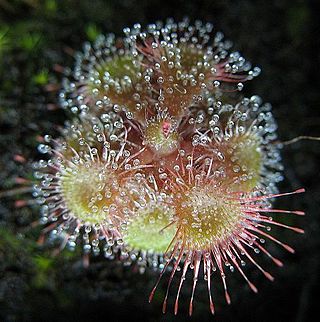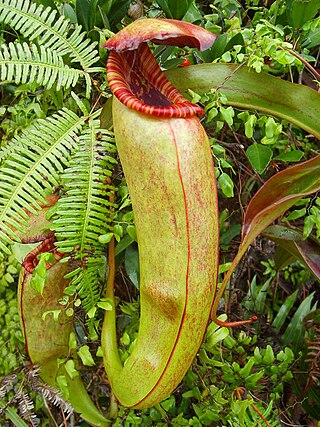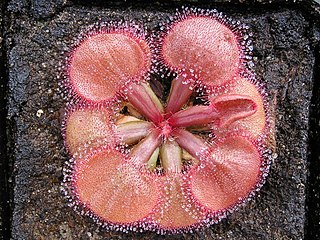
Drosera, which is commonly known as the sundews, is one of the largest genera of carnivorous plants, with at least 194 species. These members of the family Droseraceae lure, capture, and digest insects using stalked mucilaginous glands covering their leaf surfaces. The insects are used to supplement the poor mineral nutrition of the soil in which the plants grow. Various species, which vary greatly in size and form, are native to every continent except Antarctica.

Drosophyllum is a genus of carnivorous plants containing the single species Drosophyllum lusitanicum, commonly known as Portuguese sundew or dewy pine. In appearance, it is similar to the related genus Drosera, and to the much more distantly related Byblis.

Drosera capensis, commonly known as the Cape sundew, is a small rosette-forming carnivorous species of perennial sundew native to the Cape in South Africa. Because of its size, easy to grow nature, and the copious amounts of seed it produces, it has become one of the most common sundews in cultivation, and thus, one of the most frequently introduced and naturalised invasive Drosera species.
Pachypodium bicolor is a species of plant in the family Apocynaceae.

Pachypodium brevicaule is a species of plant that belongs to the family Apocynaceae.

Drosera spatulata, the spoon-leaved sundew, is a variable, rosette-forming sundew with spoon-shaped leaves. The specific epithet is Latin for "spatula shaped," a reference to the form of the leaves. This sundew has a large range and occurs naturally throughout Southeast Asia, southern China and Japan, Micronesia, Papua New Guinea, eastern Australia, Tasmania and New Zealand. Variants are often known by the localities in which they are found. The plant does not form hibernacula in winter, and is easily grown using the same methods as Drosera capensis.

Drosera regia, commonly known as the king sundew, is a carnivorous plant in the sundew genus Drosera that is endemic to a single valley in South Africa. The genus name Drosera comes from the Greek word droseros, meaning "dew-covered". The specific epithet regia is derived from the Latin for "royal", a reference to the "striking appearance" of the species. Individual leaves can reach 70 cm (28 in) in length. It has many unusual relict characteristics not found in most other Drosera species, including woody rhizomes, operculate pollen, and the lack of circinate vernation in scape growth. All of these factors, combined with molecular data from phylogenetic analysis, contribute to the evidence that D. regia possesses some of the most ancient characteristics within the genus. Some of these are shared with the related Venus flytrap (Dionaea muscipula), which suggests a close evolutionary relationship.

Drosera peltata, commonly called the shield sundew or pale sundew, is a climbing or scrambling perennial tuberous species in the carnivorous plant genus Drosera. Among the tuberous sundews, D. peltata has the largest distribution, which includes eastern and western Australia, New Zealand, India, and most of Southeast Asia including the Philippines. The specific epithet is Latin for "shield shaped", a reference to the shape of the cauline leaves. It is either a single extremely variable species, or a complex of several closely related species of uncertain taxonomic boundaries. In Australia at least four forms have had or still have specific taxonomic recognition: Drosera peltata subsp. peltata, D. peltata subsp. auriculata, D. foliosa and D. gracilis.

Aldrovanda is a genus of carnivorous plants encompassing one extant species and numerous extinct taxa. The genus is named in honor of the Italian naturalist Ulisse Aldrovandi, the founder of the Botanical Garden of Bologna, Orto Botanico dell'Università di Bologna. Aldrovanda vesiculosa has been reported from scattered locations in Europe, Asia, Africa, and Australia.

Nepenthes rigidifolia is a critically endangered tropical pitcher plant endemic to Sumatra, where it grows at elevations of 1000–1600 m above sea level.

Drosera burmanni, the tropical sundew, is a small, compact species in the carnivorous plant genus Drosera. Its natural geographical range includes the tropical and subtropical regions of Asia, Australia, India, Japan, southeast Asia, Oceania, Africa and China's Guangxi, Guangdong, Yunnan, Fujian, Taiwan. It normally spans only 2 cm (0.8 in) in diameter. It is one of the fastest trapping sundews as well, and its leaves can curl around an insect in only a few seconds, compared to the minutes or hours it takes other sundews to surround their prey. In nature, D. burmanni is an annual, but in cultivation, when grown indoors during the cold months, it can live for many years. Since D. burmanni is an annual, it produces large amounts of seed. Drosera burmanni has been considered a powerful rubefacient in Ayurveda.

Drosera indica is an insectivorous plant, a sundew native to tropical countries throughout the world, from Asia to Africa, but absent from the neotropics. Together with Australian endemic species D. aquatica, D. aurantiaca, D. barrettorum, D. cucullata, D. finlaysoniana, D. fragrans, D. glabriscapa, D. hartmeyerorum, D. nana, D. serpens it makes up the section Arachnopus.

Plumbago auriculata, the Cape leadwort, blue plumbago or Cape plumbago, is a species of flowering plant in the family Plumbaginaceae, native to South Africa and Mozambique.

Nepenthes bokorensis is a tropical pitcher plant endemic to Cambodia. It is known from Mount Bokor in the south of the country, and an as yet undetermined specimen suggests that it may also be present in other parts of the Dâmrei Mountains of Kampot Province. The specific epithet bokorensis refers to both Mount Bokor and Bokor National Park.

Drosera linearis, commonly called the slenderleaf sundew, is a sundew found in the Great Lakes region of North America, in Canada and the United States, such as Michigan, and in Montana. It is usually no more than four inches tall.
Endosamara is a monotypic genus of flowering plants in the legume family Fabaceae, tribe Wisterieae. Its only species is Endosamara racemosa, a liana found from South India through Indo-China to the Philippines.

Drosera falconeri is a carnivorous plant in the genus Drosera. It is endemic to the Northern Territory of Australia.

Drosera kaieteurensis is a plant from the sundew family (Droseraceae).

Ipomoea oenotherae is a species of plant of the morning glory genus, Ipomoea, in the family Convolvulaceae. It derives its name from the resemblance it bears to plants in the genus Oenothera. Ipomoea oenotherae is a succulent and a cryptophyte.

Passiflora bogotensis is a climbing plant native to Colombia, in the genus Passiflora. It can also be found in Venezuela.



















